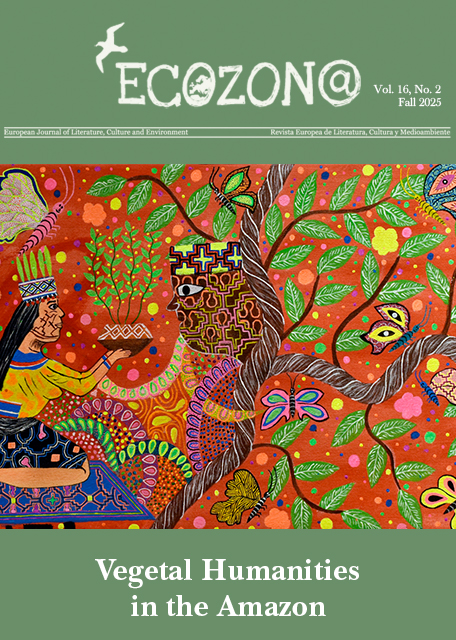<b>James Joyce's Urban EcoAnarchism</b> // El ecoanarquismo urbano de James Joyce
DOI:
https://doi.org/10.37536/ECOZONA.2016.7.2.860Keywords:
Finnegans Wake, Vico, EcoAnarchism, urban ecology, post pastoral // Finnegans Wake, ecoanarquismo, ecología urbana, post-pastoralAbstract
In this paper I contend James Joyce invests Finnegans Wake’s river-woman Anna Livia Plurabelle with the agency to reconnect Dublin’s inhabitants to the environs that resource their urban ecology. In early twentieth-century Dublin, Nature retained the fearsome power of Giambattista Vico’s thunderclap. Regular typhoid outbreaks contributed to increased infant mortality rates in the inner city; and, as Anne Marie D’Arcy observes, the River Liffey delta could not absorb the raw sewerage discharged from the city’s wealthy coastal townships, so this washed upriver, offering the ideal conditions for typhoid’s parasitic bacterium to multiply. There is no place for the Romantic sublime in such a setting. Yet Finnegans Wake nurtures the hope that Dubliners might remediate their city’s urban ecology. Anna Livia “gifts” the city three key means to this end: birth control to limit population growth, an uprising of the poor to redistribute wealth, and gout to curb greed and thus reduce natural resources consumption. While these steps might initiate the beginning of an egalitariansociety in Dublin, they require the city’s inhabitants to gain a heightened consciousness of their actions. With such a revolution, recalling Peter Kropotkin’s EcoAnarchism, played out on an intergenerational timescale, urban Dublin could regain equilibrium with the environs that sustain it, countering the global phenomenon of the ‘Great Acceleration’. Reading the Wake as ecoanarchism is one approach to discover that, like his fictional alter-ego Stephen, Joyce seeks to change the urban ecology of Dublin by pricking the conscience of generations of readers who enjoy the privileges of education, and contemplation.
Resumen
Este trabajo argumenta que James Joyce otorga a Anna Livia Plurabelle, la “mujer del río” de Finnegans Wake’s el poder para reconectar a los habitantes de Dublín con los alrededores que forman su ecología urbana. En el Dublín de principios del siglo veinte, la naturaleza retenía el poder aterrador del trueno de Giambattista Vico. Brotes frecuentes de fiebre tifoidea contribuían al aumento de la tasa de mortalidad infantil en el centro de la ciudad, y, como destaca Anne Marie D’Arcy, el delta del río Liffey no podía absorber las aguas residuales que venían de los ricos municipios costeros, así que ésta subía a contracorriente, creando las condiciones óptimas para el desarrollo de la bacteria que produce la fiebre tifoidea. No hay lugar para el concepto de lo “sublime” del Romanticismo en este escenario. Sin embargo, Finnegans Wake de Joyce alimenta la esperanza de que los dublineses quizá puedan remediar la ecología urbana de su ciudad. Anna Livia ofrece a la ciudad tres claves al respecto: métodos anticonceptivos para disminuir el crecimiento poblacional, el levantamiento de las clases pobres a fin de exigir la redistribución de la riqueza, y la gota para contener la codicia y de ese modo reducir el consumo de recursos naturales. Aunque estos pasos tal vez iniciarían el principio de un Dublín más justo y equitativo, requerirían que los habitantes de la ciudad fueran más conscientes de sus acciones. Con esta revolución, evocando el ecoanarchismo de Peter Kropotkin y aplicándolo a una escala de tiempo intergeneracional, el Dublín urbano podría recuperar el equilibrio con los alrededores que lo mantienen, contrarrestando el fenómeno global de la “Gran Aceleración”. Leer Finnegans Wake desde el punto de vista del ecoanarquismo es una forma de descubrir que, como su álter ego Stephen, Joyce busca cambiar la ecología urbana de Dublín, apelando la conciencia de generaciones de lectores que disfrutan los privilegios de la educación y de la contemplación.
Downloads
Downloads
Published
Issue
Section
License
Authors who publish with this journal agree to the following terms:
a) Authors retain copyright and grant the journal right of first publication with the work simultaneously licensed under a Creative Commons Attribution License that allows others to share the work with an acknowledgement of the work's authorship and initial publication in this journal (CC BY-NC for articles and CC BY-NC-ND for creative work, unless author requests otherwise.
b) Authors are able to enter into separate, additional contractual arrangements for the non-exclusive distribution of the journal's published version of the work (e.g., post it to an institutional repository or publish it in a book), with an acknowledgement of its initial publication in this journal.
c) Authors are permitted and encouraged to post their work online (e.g., in institutional repositories or on their website) prior to and during the submission process, as it can lead to productive exchanges, as well as earlier and greater citation of published work (See The Effect of Open Access).










